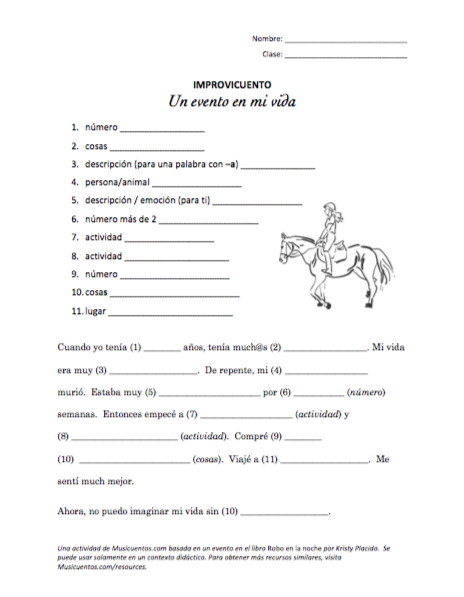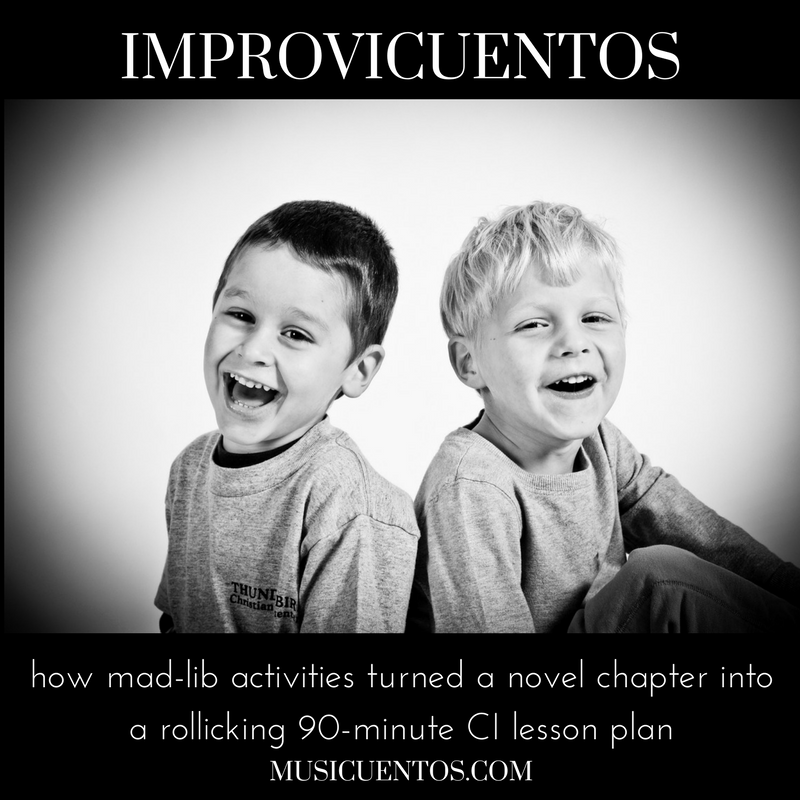Do you remember Mad Libs?
As I was planning my semester around our novel Robo en la noche and our unit’s Driving Question:
What can we create and share to show an interesting itinerary for a five-day trip in Costa Rica?
it occurred to me that Mad Libs would be a fun way to explore a chapter here and there. Students get more comprehensible input with opportunities for production that let them show off what they know in a low-stress context? Win.
My entire school year with my high school girls is built around narrating a story in the past. For all of them to feel successful at some level with that language function, they need a ton of input and scaffolding. Cue this Mad Lib idea. Recently, I (fairly quickly) built an entire 90-minute lesson plan around Mad Libs as a new way to do the “same old thing”: explore past narration.
First, you should know…
Context: My students are in an all-female class of 6 (yes, 6) and are ages 15-17. They’re fairly evenly mixed as far as aptitude and motivation go. I see them once a week for 90 minutes for 16-week semesters, as long as no one’s sick and it’s not snowing. Four are in their third year with me, two in their second year, and at 90 minutes once a week, they’re a mix of Novice Mid and Novice High proficiencies.
Here’s how I set up my lesson.
In chapter 5 of Robo en la noche, one of the characters tells about a past event in her life, when someone she loved died, and where her journey took her after that. Not exactly the first thing you’d think of when developing a Mad Lib, but that was our chapter, and it was the most evident piece of the chapter to use to work with.
I decided to frame my chapter with mad lib activities I found online, then ask my learners to do the mad lib I wrote based on Un evento en mi vida on their own. They’d know what they were doing, be prepped for success, yay! So before and after we read the chapter, we did two mad lib activities: Una sorpresa en la noche generously offered by Martina Bex and also Spanish 411’s interactive option. Then, I sent home my mad lib (I came up with the name improvicuento for them) and they were ready to try it.
Now, here’s why I decided I needed to make more of these on my own. First, I mean, it’s fun. What a pink, smelly unicorn we found under that stuffed bear! It engaged my students in more scaffolded input to foster acquisition while still asking for some low-stress production.
But also… there was the issue of the grammatical terms.
I’d put on my guilty face if I felt guilty about it but I’ll just go ahead and tell you, my learners couldn’t tell you an artículo indefinido from an adjetivo. We simply don’t use grammatical terms in my class because it’s not a grammar class. When my students started asking “What’s pretérito?” (Me: “Súbito, chicas, súbito“) I knew I needed to see what I could do to create improvicuentos without grammatical terms. And so I tried. And it worked – in my class, anyway!
Our lesson plan went:
- Spanish411 mad lib
- Novel chapter (with another Spanish411 to break it up)
- Martina’s mad lib (at stations in teams of 2)
- My mad lib sent home
And 90 minutes was gone before we knew it.
Want to use the improvicuento I made about Un evento en mi vida? Please do! Click the image to download it:

Want more? I made five more improvicuentos for novice-level Spanish. All verbs are in past, mostly sudden past, but learners are not asked to conjugate any verbs. Their titles are:
- En el restaurante
- En la playa
- Las cartas del correo
- Listo para el partido
- Un regalo para el cumpleaños
Especially if they work in pairs and not alone and then present to each other / groups / the whole class, or if I use them as more comprehensible input and repetitions by reading student cuentos myself, I can easily fill 45 minutes with 1 improvicuento. If learners know the vocabulary and know how to interact with them, they’re also a creative target-language, comprehensible sub plan even in the absence of a Spanish-speaking sub. You can get them individually in my store, or you can get all five in a bundle.
Y ahora, ¡a crear cuentos!
 If Musicuentos has significantly helped you in your language teaching journey, consider becoming part of the “thanks” crew on Patreon. “La lotería” patrons receive every resource I produce, whether it’s a $2 activity or a $50 ebook guide, as thanks for their sponsorship.
If Musicuentos has significantly helped you in your language teaching journey, consider becoming part of the “thanks” crew on Patreon. “La lotería” patrons receive every resource I produce, whether it’s a $2 activity or a $50 ebook guide, as thanks for their sponsorship.




